2011 Peregrine Nestbox News
Nestbox News is an account of activity at a nestbox atop Mack-Cali Realty Corporation's 101 Hudson, Jersey City, by biologists in the Endangered and Nongame Species Program (ENSP). Follow this chronicle of the nesting behavior and activity of peregrine falcons and their chicks. We encourage viewers to help support the webcam and all the work of the ENSP through the Income Tax Check-off for Wildlife and Conserve Wildlife License Plates. We appreciate and value your support, as well as the support we've received from the Conserve Wildlife Foundation of NJ and the Mack-Cali Realty Corporation and its staff at 101 Hudson - without their cooperation the nestbox and webcam would not be possible.
September 27, 2011 - Prey Transfer
September 1, 2011 - Chick Update by Bonnie Talluto
While under evaluation at the Three Rivers Avian Center in West Virginia prior to hacking, it was determined that tbe eyas was not suitable for release. The bird had lost its tail feathers and would have trouble flying. There also seemed to be another developmental problem. But a more important consideration was that the bird was not relating to the other peregrines and the other peregrines were treating the bird as different. It was learned later from Dr. Erica Miller that when the bird first came to Tri-State Bird Rescue & Research in Newark, Delaware, that there was no other raptor available where the bird could be housed and learn appropriate behaviors. Upon the eyas' return to Tri State, Mr. Phung Luu of Dover, Delaware, a world-renowned avian flight trainer and animal behavior specialist, agreed to take him. Fellow WCC volunteer Mike Girone and I had the privilege of meeting Mr. Luu and see his free-flight demonstration at a Tri-State benefit in Delaware in July. Mr. Luu and his assistant, Jackie, both said that the bird from 101 Hudson will be a fabulous educator bird. We are planning to see the fledgling when he makes his first public appearance, after his flight feathers have grown in. Pictures show that he has turned into a magnificent looking peregrine. He should have a good, long life with Mr. Luu.
July, 2011 - Fledgling Watch
June 20, 2011: Fledgling News
June 16, 2011 - Empty Nest Syndrome
With the young out of the nest box, and no rooftop camera operating, we will be shutting the webcam off. The Endangered and Nongame Species Program pays quite a high price for transmitting this webcam image, so turning off the signal means keeping money to be used elsewhere in endangered and threatened wildlife research and management! We thank all the falcon-fans for their care and watching this season. We will provide updates here in Nestbox News of the fledglings when they are sighted by our dedicated street observers!
June 9, 2011 - Out and About!
There is good news from Tri-State Bird Rescue & Research. The J.C. nestling that was removed from the nest on May 14 because of its small size and inability to stand was treated successfully! He was deemed healthy and was sent to West Virginia yesterday with a group of 11 other peregrine nestlings. (Click for photo) The WV Dept. of Natural Resources and Three Rivers Avian Center are partners in a peregrine hacking program in the New River Gorge National River. Peregrines donated from New Jersey, Delaware and Virginia are set for release into the cliff and mountain region, where it's hoped they will return when they are old enough to nest. More details on the hacking project are available at www.tracwv.org/restoration.html (not yet updated with 2011 information). We in New Jersey are happy to have enough peregrine nestlings to help with the peregrine's restoration into the southern Appalachian Mountains. Most of the NJ nestlings came from bridge nests where fledging success is usually suboptimal. We are very grateful to Dr. Erica Miller and Tri-State for the great work they do, and in particular for the creative and successful treatment of the little peregrine who needed a little help.
June 7, 2011 - Growing Fast
Viewers will note how much they perch on the front rim of the box. This evening, they each took turns pulling at the remains of a prey carcass, learning how to feed themselves. They also spent time vocalizing in the direction of a parent, apparently begging for a food delivery. They're not quite ready to give up room service! The male is slightly more brown than the female; with his slightly smaller body size, his feathers will be full grown a little sooner than his sister. It's likely he will want to venture out of the box first, but that remains to be seen. Once they leave the nest box, we will lose sight of them. Even when the outside camera was working, the chicks were within camera range only irregularly. They walk all over the roof, and will run and flap as they exercise their wings and get the feel of the lift they produce. The flapping exercise is important for muscle development that will help make their first flight successful. That will happen sometime in the next week or two.
June 1, 2011 - Banding Report
(Thanks to Mike for allowing use of his photos, above, and for posting more at Flickr.)
Both chicks looked perfectly healthy and in great body condition. They were given a follow-up antibiotic treatment as a precaution against Trichomoniasis, since they have a lot of pigeon in their diet. The work went quickly and the chicks were returned to the nestbox under watchful peregrine eyes. Before leaving, the 2x6 board that serves as a ramp was placed for the chicks to get back in the box, should they need to, after they hop out and onto the building roof. It's likely they will do so in the next week or so, as they get anxious to move about more. Today's visit should be the last this season; once the nestlings start hopping about, it's not safe for anyone to be in the nest area lest a young one get spooked and try to leave before they're able to fly. In just two to three short weeks, they will be testing their wings for real. The third nestling from this nest, which was removed on May 14th due to a problem with its legs, is doing very well at Tri-State Bird Rescue & Research. The extra attention and some treatment to support his legs seem to be working, and he is a candidate for release into the wild pending additional work and evaluation. Many thanks to the medical staff at Tri-State for putting him on the right road, or flyway!
May 31, 2011 - Banding Day
May 19, 2011 - Jersey City Alumnus Sighted The female with black-over-red band M/*S had been sighted in Brooklyn in 2009, but last week was sighted at a recently found nest on the Brooklyn Detention Complex, in one of the recessed windows on the building. She may have nested there last year as well, and it's likely she has nested in Brooklyn since becoming mature (approximately 2007). It appears she has a very secure nest site, as the partial grate over the window provides some additional protection; it also creates the appearance of "chicks behind bars" as local observers have joked! We thank Barbara Saunders of NY Dept. of Environmental Conservation for providing this resighting and photo.
May 17, 2011 - Chick Update
Dr. Miller says that it does have splayed legs that are keeping it from standing properly, but she has begun treating it to attempt to improve the function of the chick's legs. The bird is also on a calcium supplement. There does not seem to be any other deformity. With a lot of luck, this bird may recover. We will have to see if he becomes well enough to make it out in the wild.
May 16, 2011 - Nest Check
The smallest chick was showing some problem with its legs such that it could not stand and therefore was not getting its share at feeding time. The chick will be evaluated to see if it can be treated successfully, but it probably cannot be returned to the Jersey City nest because it is too far behind developmentally. The good news is the remaining two chicks looked very strong and healthy, and they got an extra boost by the medicine provided today to ward against Trichomoniasis, a pigeon-borne disease to which urban peregrines can be vulnerable. There was no sign of the fourth chicks suspected to have hatched and died quickly; some viewers reported seeing the adult remove it from the nest last week. The adults were at their most defensive Saturday, making it a real challenge to get to and from the nest. The female will continue to brood them closely for the next week, when the chicks have more down feathers to keep themselves warm; then the adults will need to spend more time hunting to provide for the very fast-growing, hungry chicks.
May 11, 2011 - Just Three Chicks
Today, during a feeding which began at 9:40am, it was clear that only three chicks are in the nestbox. During that feeding one chick was "pinned" by one of its siblings and unable to sit erect to receive any food. However, during a subsequent feeding it was sitting up alot and getting fed. We will monitor the video throughout the day to ensure the third chick was just unlucky during the 9:40 feeding or if it too is at risk. Sometimes, despite the best efforts of biologists and the chicks' parents, not all hatchlings survive to fledge.
May 7, 2011 - Three Chicks Confirmed
A regular viewer in The Netherlands (Dutch Eagle Fan) captured the first feeding of the first chick. She shared it with the world by posting on Bird Cams Around the World; it can also be viewed on YouTube at www.youtube.com/watch?v=59UuLqO4K2k. We thank her for making this unique and incredible video available to everyone. We'll keep watching and hope we have the fourth chick soon.
May 6, 2011 - HATCHING!
8:10 a.m.: Staff taking a break from usual duties were lucky enough to see the female move and tuck a newly hatched chick back underneath her. What appeared to be an unhatched egg was also glimpsed. Hopefully there will be a full healthy clutch of four chicks by tonight!
April 29, 2011 - Video Stream Down
April 21, 2011 - Incubation Continues
Incubation has now begun in earnest. Since the incubation period is typically 32-33 days we can anticipate hatching around the first week of May. Hopefully it will be an uneventful month until hatching.
April 1, 2011 - The Third Egg
March 30, 2011 - Egg Laying Continues
Eggs are usually laid every other day, and with 3-4 eggs being the norm we can expect incubation to begin in earnest the week of April 3; hatching will occur approximately a month after that. We will be updating Nestbox News periodically during that period. Enjoy your viewing!
March 23, 2011
After overcoming some technical difficulties, the webcam atop 101 Hudson Street has begun streaming live and still images over the Internet! Staff has observed both adults on the roof and there is a scrape in the nestbox awaiting a clutch of eggs. Since egg laying typically occurs between late March and the end of April we can anticipate it at any time. Incubation begins only after all the eggs (usually 3-4) have been laid and lasts 32 to 33 days. The new box installed last year weathered the intense winter storms well, but the "outside" camera housing didn't fare as well, so for the time being we will only have one still image (captured from the live "inside" camera) available. We hope to have the second camera repaired and sending images soon. This is sure to be another exciting year observing the peregrine falcons using the nestbox maintained by the NJDEP Division of Fish and Wildlife's Endangered and Nongame Species Program. The first nestbox was installed in 2001 and has fostered the successful fledging of young every year since (see About the Peregrine Project for a history of the project). As the economy slowly recovers funding for projects such as this remains hard to obtain - the Peregrine Project, like other projects conducted by the ENSP, is funded entirely by grants and donations. Please help this project continue by making a direct donation to the ENSP, or by "checking-off" for wildlife on your state income tax return. By becoming a partner in the work of ENSP you can proudly feel you are doing your part in protecting our endangered and threatened species. We hope you enjoy following the Jersey City peregrines this season; it's sure to be as exciting - and hopefully as successful! - as it has in past years. |
|||||||||||||||||||||||||
|
||
|
|
||
|
||
| |
||

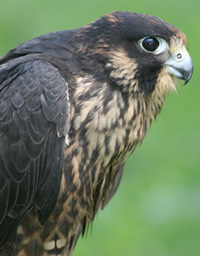
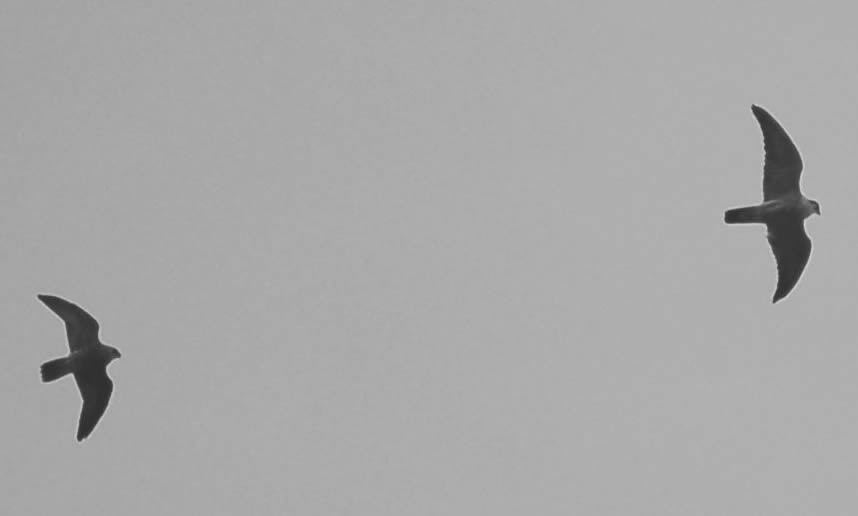
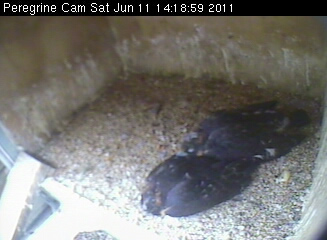 Peregrine Project volunteer Mike G. was watching from the streets on Tuesday and documented fledging by the juvenile female (06/AN), who was seen perched on Exchange Place, about one block away from 101 Hudson Street. Fledging at just 5 ½ weeks of age is early for a female (females generally fledge at 6 to 7 weeks of age, while males fly at 5 to 6 weeks)….she seemed very anxious to be out and about! The male (17/AC) was still near the nest ledge, probably not yet fledged. By this date it's likely he has also tested his wings.
Peregrine Project volunteer Mike G. was watching from the streets on Tuesday and documented fledging by the juvenile female (06/AN), who was seen perched on Exchange Place, about one block away from 101 Hudson Street. Fledging at just 5 ½ weeks of age is early for a female (females generally fledge at 6 to 7 weeks of age, while males fly at 5 to 6 weeks)….she seemed very anxious to be out and about! The male (17/AC) was still near the nest ledge, probably not yet fledged. By this date it's likely he has also tested his wings.
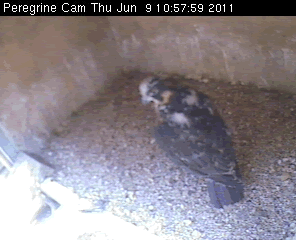 This morning, the female youngster has been going in and out of the box using the ramp on the far left side, and about 9:50 this morning, the young male was observed walking down the ramp himself, for the first time. This is one of their first milestones in fledging, so they now have the larger roof area across which they will walk, run and flap and build up their muscles.
This morning, the female youngster has been going in and out of the box using the ramp on the far left side, and about 9:50 this morning, the young male was observed walking down the ramp himself, for the first time. This is one of their first milestones in fledging, so they now have the larger roof area across which they will walk, run and flap and build up their muscles.
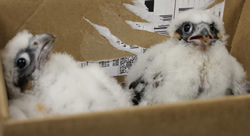
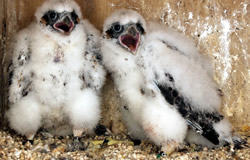
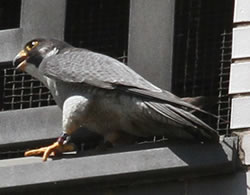
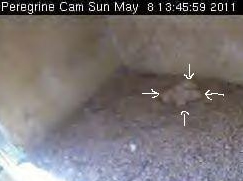 May 8, 2011 - Four Healthy Chicks
May 8, 2011 - Four Healthy Chicks
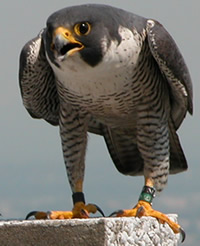
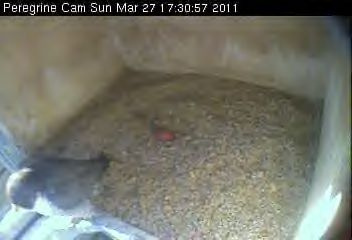 March 28, 2011 - The First Egg
March 28, 2011 - The First Egg